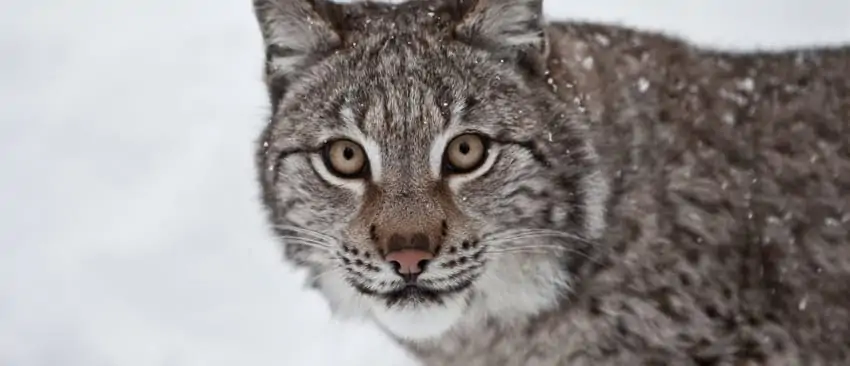
The Canada Lynx is a medium-sized feline known for its ability to stealthily roam the northern Minnesota woods. Their bodies vary in color from shades of brown to beige with dark spots. There are four species of lynx in the world, with two living in Minnesota: the Canada Lynx and the Bobcat. All four species have a white furry chest that grooms down onto the inside of their legs. They have abnormally large padded paws that assist them when walking in the deep snow, similar to a human snowshoe.
Standing roughly 19 to 22 inches tall and with an overall head and body length of 32-40 inches, the Canada Lynx is about two times the size of the average house cat. Their hind legs are longer than their front legs, giving them a stooped appearance which makes them seem larger than they actually are.
The Canada Lynx can be very vocal animals and make a variety of hissing, chattering and yowling sounds. Closely related to the bobcat, the two are difficult to distinguish from one another. A few features that set them apart are the height of their back hips (the hips of a bobcat are about the same height as their shoulders, while lynx have higher hips than shoulders), the length of the black tufts on their ears (lynx have longer tufts) and the color of the tip of their tail (lynx have an all-black tip, whereas bobcats have white fur under the tip).
Reproduction
Lynx will mate in late winter or early spring and then about two months later, the female lynx gives birth to a litter ranging from one to four kittens. Strangely enough, lynx does not create a den for their litter. Instead, they find an existing feature such as a root system or a downed log that provides protection. The male has no role in parenting the kittens and the females stay with the young for about a year, or until they learn to hunt. The lynx population in Minnesota peaks every 10 years in correlation with the snowshoe hare, their main food source.
Food
The lynx is an incredibly skilled hunter. They are a dual-threat, featuring amazing hearing and sight. Their eyes are keen enough to spot a mouse 250 feet away! The lynx is a carnivore and eats mice, squirrels, birds, and deer, but their preference is snowshoe hare. They hunt primarily on the ground, but can also climb trees and swim, making fish a part of their diet as well. The lynx does not have many predators threatening them, but they have been known to be killed by wolves, bobcats, and humans from time to time. Lynx hunt exclusively at night and then sleep during the day. They rely heavily on their senses to stalk and ambush their prey in the dark.
Spotting One
The lynx population fluctuates in the United States as they periodically move into Canada as the weather changes and as the snowshoe hare population varies. There are about 250 lynx roaming the wild, making it a federally threatened species. They prefer cold wilderness areas and dense coverings of brush, shrubs, and grass. They typically patrol an area up to 40 square miles.
If you think you have seen one of these elusive animals, be sure to report your rare sighting to the DNR with the date, time and location of the observation.
